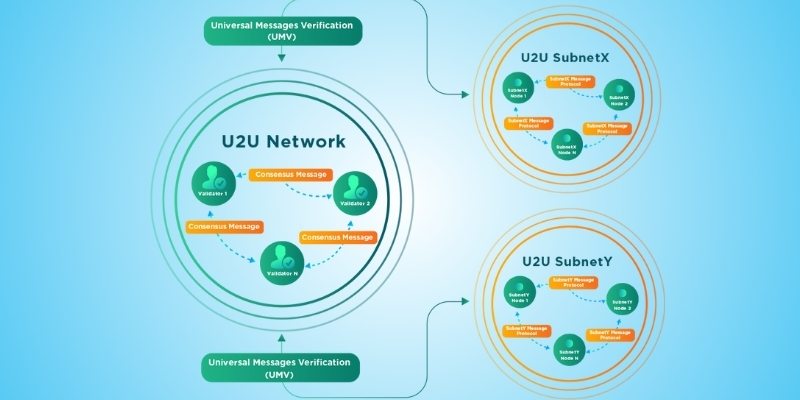As blockchain technology advances, the U2U Network emerges as a pioneering Layer-1 blockchain, offering unparalleled scalability, security, and interoperability. With a strong emphasis on Decentralized Physical Infrastructure Networks (DePIN), U2U is transforming how decentralized applications (dApps) and real-world systems interact. But how does U2U Network work? In this article, we delve into its technical architecture, consensus mechanisms, and practical applications, providing a clear and authoritative explanation for developers, businesses, and enthusiasts.
U2U Chain: A High-Performance Backbone
The U2U Chain is the core of the U2U Network, built on a Directed Acyclic Graph (DAG) architecture. Unlike traditional blockchains that rely on linear block creation, DAG allows transactions to be processed in parallel, significantly enhancing throughput. The network achieves up to 17,000 transactions per second (TPS) per shard, with potential peaks of 73,000 TPS, and finalizes transactions in under 650 milliseconds.
How does U2U Network work to deliver such speed? The DAG structure eliminates the need for sequential processing, enabling simultaneous transaction validation across the network. This makes U2U ideal for high-throughput applications, particularly in DePIN ecosystems like IoT, decentralized storage, and healthcare.

Helios Consensus: Balancing Security and Sustainability
Central to U2U’s operation is its Helios Consensus Mechanism, which integrates Asynchronous Byzantine Fault Tolerance (aBFT) and Delegated Proof of Stake (DPoS). This hybrid approach ensures both robust security and energy efficiency.
-
aBFT: Provides fault tolerance, allowing the network to function correctly even if some nodes are compromised or fail.
-
DPoS: Enables token holders to delegate their stake to validators, reducing the computational burden and energy consumption compared to Proof of Work (PoW).
This consensus model is a critical component of how does U2U Network work to maintain a secure, scalable, and eco-friendly blockchain. It supports rapid transaction validation while aligning with environmental sustainability goals.
Subnets: The Key to Scalability
U2U’s subnet architecture is a game-changer for blockchain scalability. Subnets are independent, customizable sub-networks that operate under the main network’s security and consensus framework. Developers can tailor subnets for specific use cases, such as IoT ecosystems, healthcare data management, or decentralized cloud services.
How does U2U Network work to scale infinitely? By distributing workloads across subnets, U2U prevents mainnet congestion and ensures high performance. Subnets remain operational even during mainnet downtime, enhancing reliability. The network employs three node types:
-
Master Nodes: Manage transactions and cross-network communication.
-
Validator Nodes: Use Trusted Execution Environments (TEE) and Fully Homomorphic Encryption (FHE) to secure data.
-
Edge Nodes: Contribute resources like bandwidth or storage, earning rewards.
This architecture empowers U2U to support resource-intensive DePIN applications, such as its flagship U2DPN decentralized VPN.
Interoperability and DePIN Applications
Interoperability is a hallmark of U2U’s design. The network leverages the Inter-Ledger Protocol (ILP) to enable seamless asset transfers and communication with other blockchains and traditional systems. This ensures U2U integrates effectively with the broader Web3 ecosystem.
A primary focus of U2U is Decentralized Physical Infrastructure Networks (DePIN). How does U2U Network work in this domain? By enabling devices to act as nodes that share resources like bandwidth, CPU, or storage, U2U creates decentralized ecosystems. The U2DPN, a decentralized VPN, has facilitated over 113,000 sessions and shared 69,000+ GB of bandwidth, offering users privacy and passive income opportunities. This real-world application underscores U2U’s ability to bridge blockchain with practical use cases.

The U2U Token: Fueling the Ecosystem
The U2U token (1 billion total supply) is the lifeblood of the network, used for:
-
Staking: Securing the network through DPoS, with rewards ranging from 5–15% APY.
-
Transaction Fees: Covering network operations and cross-chain transfers.
-
Governance: Empowering token holders to vote on network proposals.
This token economy is integral to how does U2U Network work as a decentralized platform. Staking ensures network security, while governance promotes community-driven development.
Developer-Friendly Ecosystem
U2U is EVM-compatible, enabling developers to migrate Ethereum-based dApps with ease. It supports programming languages like Python, Go, Rust, and TypeScript, and provides tools such as:
-
U2UScan: For blockchain exploration.
-
The Graph: For data indexing and querying.
-
Bridge Technology: For cross-chain interoperability.
The U2U Super App, with thousands of downloads, simplifies user interaction with the ecosystem. With over 80 dApps and 1 million users, U2U’s ecosystem is rapidly expanding, supported by strategic partnerships like GPU.net.
Real-World Impact and Vision
U2U’s impact is evident in its DePIN applications and growing adoption. The U2DPN demonstrates its ability to deliver scalable, privacy-focused solutions, while its broader ecosystem supports diverse use cases, from IoT to decentralized computing. Backed by $13.8M in funding and led by industry veterans like CEO Luu Tran, U2U is poised to lead the next wave of blockchain innovation.
In summary, how does U2U Network work? It combines a DAG-based U2U Chain, Helios Consensus, scalable subnets, and DePIN-focused interoperability to create a high-performance, secure, and developer-friendly blockchain. Its real-world applications and robust ecosystem make it a cornerstone of Web3’s future.
Learn more at u2u.xyz or the official documentation at docs.u2u.xyz.

